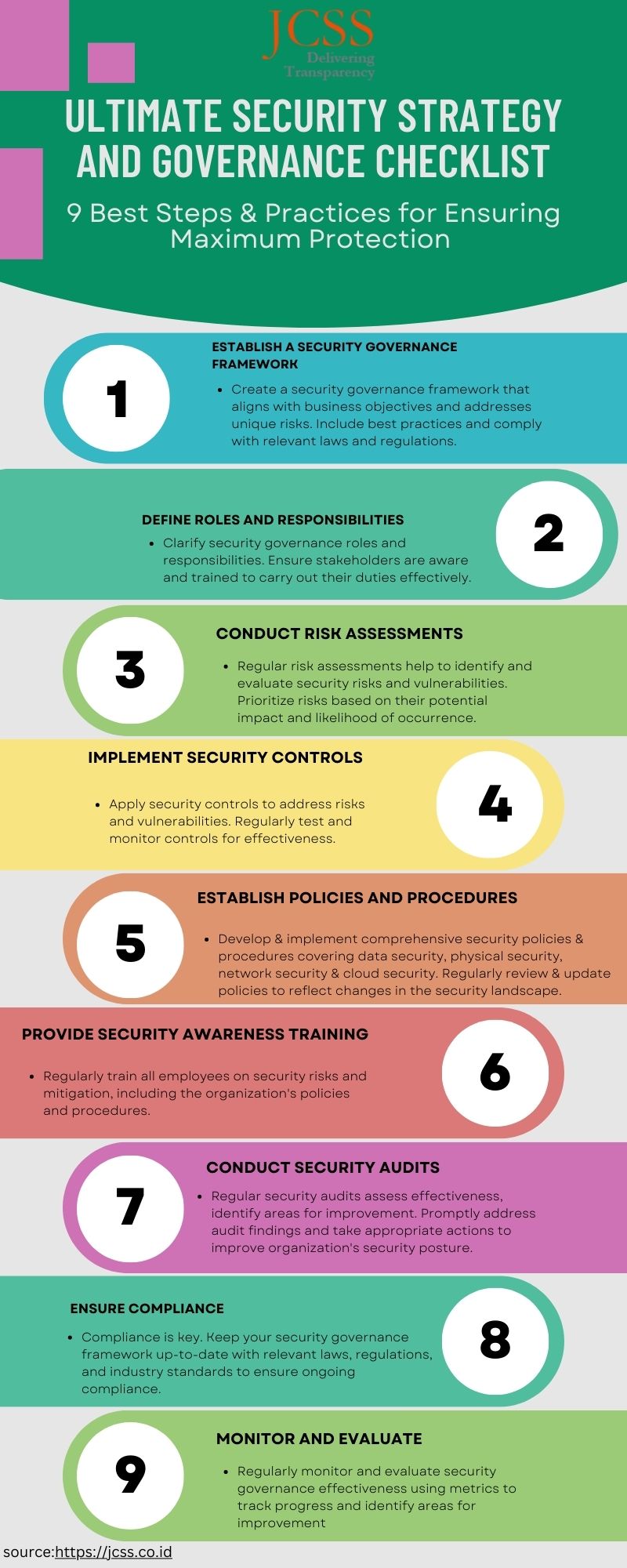Table of Contents
ToggleHow to Safeguard Your Organization's Network, Data, and Physical Assets from Cyber Threats

As technology advances, so do cyber threats, making security governance and compliance more important than ever. The security of an organization’s data, network, and physical assets is crucial to its success and longevity. To help ensure your security strategy and governance are up to par, we’ve compiled the ultimate checklist of best practices.
From IT security governance to data security governance and everything in between, this article will cover the key principles, processes, and policies necessary for a robust security governance framework. We’ll also discuss the importance of security governance, the challenges faced by organizations, and how to mitigate risks.
Our checklist is based on industry-leading sources and includes relevant examples and case studies to help you better understand how to implement best practices. We’ll also provide social proof of our expertise in the field.
By following our checklist and implementing our recommended security governance framework, you can safeguard your organization from cyber threats and ensure maximum protection.
At the end of this article, we’ll provide a call to action, encouraging readers to fill out a sign-up form for a free consultation to get their security strategy on the right track.
So, if you’re searching for guidance on how to do security strategy and governance, look no further. Our ultimate checklist has got you covered.
#Step 1: Establish a Security Governance Framework
One of the most critical aspects of a robust security strategy is establishing a comprehensive security governance framework. A security governance framework defines the roles, responsibilities, policies, and procedures necessary to manage and mitigate security risks effectively.
To develop a security governance framework, it is crucial to start by conducting a thorough risk assessment. The risk assessment process should identify potential threats to the organization’s physical and digital assets, evaluate the likelihood of those threats occurring, and assess their potential impact.
Once the risks have been identified and evaluated, appropriate security controls must be implemented to mitigate them. These controls should be regularly monitored and tested to ensure their effectiveness.
Policies and procedures should be developed and implemented to address all aspects of security, including data security, physical security, network security, and cloud security. These policies and procedures should be regularly reviewed and updated to reflect changes in the security landscape.
Regular security awareness training should be provided to all employees to ensure that they are aware of security risks and understand how to mitigate them. In addition, regular security audits should be conducted to assess the effectiveness of the security governance framework and identify areas for improvement.
The importance of establishing a comprehensive security governance framework cannot be overstated. It is the foundation upon which all other security measures are built. Without a robust security governance framework, organizations are at risk of cyber-attacks, data breaches, and other security incidents.
Sources :
- ISO/IEC 27001:2013 – Information technology — Security techniques — Information security management systems — Requirements
- NIST Special Publication 800-53 – Security and Privacy Controls for Federal Information Systems and Organizations
- Center for Internet Security Critical Security Controls for Effective Cyber Defense
#Step 2: Define Roles and Responsibilities
As cyber-attacks become increasingly sophisticated and frequent, it is crucial for organisations to develop and maintain effective IT security governance. IT security governance refers to the policies, procedures, and controls that are put in place to ensure the confidentiality, integrity, and availability of an organization’s information assets.
One of the key components of IT security governance is information security governance. Information security governance involves the development and implementation of policies and procedures that protect an organization’s information assets from a range of threats, including cyber-attacks, data breaches, and other security incidents.
To ensure effective information security governance, organizations must first identify their information assets and the potential threats that could compromise them. They should then implement appropriate security controls, such as firewalls, intrusion detection systems, and data encryption, to mitigate these threats.
Regular security assessments should be conducted to identify vulnerabilities and assess the effectiveness of existing security controls. Incident response plans should also be developed and tested to ensure that the organization is prepared to respond quickly and effectively to security incidents.
In addition to technical controls, information security governance also involves the development of policies and procedures related to access control, password management, and employee training and awareness. Regular security awareness training should be provided to all employees to ensure that they understand their roles and responsibilities in maintaining a secure IT environment.
Effective IT security governance requires a coordinated effort across the entire organization. By implementing a comprehensive IT security governance framework, organizations can minimize the risk of security incidents and protect their valuable information assets.
Sources :
- ISO/IEC 27001:2013 – Information technology — Security techniques — Information security management systems — Requirements
- NIST Special Publication 800-53 – Security and Privacy Controls for Federal Information Systems and Organizations
- Information Security Governance: Guidance for Boards of Directors and Executive Management (IT Governance Institute)
#Step 3: Conduct a Comprehensive Security Risk Assessment
To establish a robust security strategy and governance framework, it is crucial to conduct a comprehensive security risk assessment. A risk assessment will identify potential security threats and vulnerabilities to your organization’s systems, assets, and data. It is important to conduct a risk assessment regularly to ensure that any new risks are identified, and appropriate mitigation measures are implemented.
The security risk assessment process involves identifying and assessing the likelihood and impact of various threats to your organization’s security. The assessment should include both internal and external factors that may affect your organization’s security posture. Some key areas to consider in a risk assessment include:
- Physical security risks, such as unauthorized access to premises or theft of equipment
- Information security risks, such as data breaches, malware attacks, or social engineering scams
- Compliance risks, such as failing to comply with regulatory requirements or industry standards
To conduct a comprehensive security risk assessment, it is recommended to follow established frameworks such as NIST (National Institute of Standards and Technology) or ISO (International Organization for Standardization). These frameworks provide guidelines and best practices for conducting risk assessments and implementing security controls.
Incorporating a comprehensive security risk assessment into your security strategy and governance framework is essential to ensure that your organization’s assets and data are adequately protected against potential threats. By following established frameworks and best practices, you can mitigate risks effectively and improve your organization’s overall security posture.
Sources :
- “Risk Management Framework” by the National Institute of Standards and Technology: https://www.nist.gov/risk-management-framework
- “ISO/IEC 27005 Information technology — Security techniques — Information security risk management” by the International Organization for Standardization: https://www.iso.org/standard/66534.html
#Step 4: Have a Robust Incident Response Plan
In the event of a security breach, an organization must have an incident response plan in place to mitigate any damage and resume normal operations as quickly as possible. An effective incident response plan should cover the identification of the breach, containment of the issue, eradication of the breach, and recovery of data.
The incident response plan should also identify the roles and responsibilities of those involved in responding to the breach, including the incident response team, technical personnel, and legal counsel. The plan should be tested and updated regularly to ensure that it remains effective and relevant.
Also Read: Risk And Compliance Ultimate Guide: How To Manage Your Operations, Risks, And Compliance Obligations Effectively
Also Read: Cybersecurity :10 Ways To Identify A Cyber Attack And How To Protect Yourself
Organizations can use various frameworks to help develop their incident response plan, such as the National Institute of Standards and Technology (NIST) Cybersecurity Framework and the SANS Institute’s Incident Handler’s Handbook. These frameworks provide guidance on how to prepare, detect, respond, and recover from a security incident effectively.
Reference:
- National Institute of Standards and Technology (NIST) Cybersecurity Framework: https://www.nist.gov/cyberframework
- SANS Institute’s Incident Handler’s Handbook: https://www.sans.org/security-resources/incident-handlers-handbook
#Step 5: Establish Policies and Procedures
Cloud security governance is a crucial aspect of any organisation’s security strategy, especially in today’s digital age where many companies rely heavily on cloud-based services. It involves implementing policies, procedures, and controls to ensure the confidentiality, integrity, and availability of data stored in the cloud.
One important aspect of cloud security governance is the selection of the right cloud service provider (CSP). Organizations must carefully evaluate potential providers to ensure that they meet their security requirements. CSPs should have robust security measures in place, such as multi-factor authentication, encryption, and intrusion detection and prevention systems. Additionally, CSPs should comply with relevant security standards and regulations, such as ISO 27001, SOC 2, and GDPR.
Another crucial aspect of cloud security governance is access control. Organisations must ensure that only authorized personnel have access to their cloud resources. This involves implementing strong authentication mechanisms, such as passwords, biometrics, or multi-factor authentication, and enforcing strict access policies based on job roles and responsibilities.
Regular monitoring and auditing of cloud resources are also essential for effective cloud security governance. This includes monitoring for unusual activity or security incidents and conducting regular security audits to identify and address vulnerabilities.
Some useful resources for further information on cloud security governance include the Cloud Security Alliance’s (CSA) Cloud Controls Matrix, which provides a comprehensive framework for assessing cloud security risks, and the National Institute of Standards and Technology’s (NIST) Cloud Computing Security Publication, which offers guidance on cloud security controls and risk management.
In summary, effective cloud security governance involves selecting the right CSP, implementing strong access controls, and regularly monitoring and auditing cloud resources. By following best practices and leveraging available resources, organizations can effectively protect their data and mitigate the risk of cloud-based security incidents.
#Step 6: Provide Security Awareness Training
One crucial aspect of a comprehensive security strategy and governance framework is providing security awareness training to employees. This training can help employees recognise and respond to security threats, prevent data breaches, and maintain the overall security posture of the organization.
According to the National Cyber Security Centre (NCSC), human error is a common cause of security incidents. In fact, the NCSC’s “10 Steps to Cyber Security” guidelines recommend that organizations provide “regular and tailored cyber awareness training” to all employees.
But what should this training entail? Some key topics to cover in security awareness training include:
- Identifying common security threats, such as phishing emails and malware
- Creating and maintaining strong passwords
- Reporting security incidents to the appropriate authorities
- Understanding the organization’s security policies and procedures
In addition to providing training, it’s important to regularly assess and update the training to ensure it remains effective and relevant. The NCSC recommends reviewing and updating security awareness training at least annually.
There are many resources available to help organizations develop and implement effective security awareness training programs. For example, the NCSC offers a free “Stay Safe Online” course for individuals and businesses. Additionally, the Information Security Forum (ISF) provides guidance on designing and delivering security awareness training that meets the needs of different audiences and learning styles.
By providing regular and effective security awareness training, organizations can help their employees become a vital part of the overall security strategy and governance framework.
References:
- National Cyber Security Centre. (n.d.). 10 Steps to Cyber Security. Retrieved from https://www.ncsc.gov.uk/collection/10-steps-to-cyber-security
- Information Security Forum. (2022). Delivering Effective Security Awareness. Retrieved from https://www.securityforum.org/research/delivering-effective-security-awareness/
#Step 7: Conduct Security Audits
Conducting regular security audits is an essential part of any effective security strategy and governance framework. Security audits help organizations identify potential vulnerabilities and areas for improvement in their security systems, policies, and procedures. In addition, security audits help ensure compliance with industry regulations and best practices.
There are several types of security audits that organizations can conduct, including:
- Network security audits
- Application security audits
- Physical security audits
- Compliance audits
Network security audits assess the security of an organization’s network infrastructure, including firewalls, routers, and switches. Application security audits focus on identifying vulnerabilities in an organization’s software applications. Physical security audits evaluate the physical security measures in place, such as access control systems and CCTV cameras. Compliance audits assess an organization’s compliance with industry regulations and standards, such as the General Data Protection Regulation (GDPR) or Payment Card Industry Data Security Standard (PCI DSS).
To conduct a security audit, organizations can use a variety of tools and frameworks, such as the National Institute of Standards and Technology (NIST) Cybersecurity Framework or the Information Technology Infrastructure Library (ITIL).
It’s important to note that security audits should be conducted regularly to ensure ongoing compliance and identify new potential vulnerabilities. Depending on the size and complexity of the organization, security audits can be conducted internally or outsourced to a third-party provider.
Remember, a security audit is just one piece of the puzzle when it comes to developing a strong security strategy and governance framework. It’s important to combine regular audits with ongoing risk assessments, employee training, and incident response planning to ensure your organization is fully prepared to handle any potential security threat.
References:
- NIST Cybersecurity Framework: https://www.nist.gov/cyberframework
- ITIL: https://www.axelos.com/best-practice-solutions/itil
- Information Security Checklist Template: https://www.process.st/checklist/information-security-checklist-template/
- Security Management Checklist: http://www.space4ict.com/aq/explain/SecurityMgmt-ChkList_small.html
#Step 8: Ensure Compliance
Ensuring compliance with industry regulations and best practices is a crucial part of any effective security strategy and governance framework. Compliance helps organisations mitigate risks and avoid costly fines and penalties for non-compliance.
There are many regulations and standards that organizations need to comply with, depending on their industry and geographic location. For example, organizations in the European Union need to comply with the General Data Protection Regulation (GDPR), while organisations in the United States need to comply with the Health Insurance Portability and Accountability Act (HIPAA) and the Payment Card Industry Data Security Standard (PCI DSS).
To ensure compliance, organizations should have clear policies and procedures in place, as well as ongoing training for employees. It’s also important to conduct regular audits and assessments to identify areas of non-compliance and make necessary changes.
In addition to regulatory compliance, organizations should also consider best practices for security governance, such as those outlined in frameworks like the NIST Cybersecurity Framework and ISO/IEC 27001. These frameworks provide guidance on developing a comprehensive security strategy, including risk assessments, incident response planning, and ongoing monitoring and review.
In conclusion, compliance is a critical aspect of any effective security strategy and governance framework. By ensuring compliance with industry regulations and best practices, organisations can protect themselves from potential risks and avoid costly penalties.
References
- General Data Protection Regulation (GDPR): https://ec.europa.eu/info/law/law-topic/data-protection_en
- Health Insurance Portability and Accountability Act (HIPAA): https://www.hhs.gov/hipaa/index.html”
- Payment Card Industry Data Security Standard (PCI DSS): https://www.pcisecuritystandards.org/
- NIST Cybersecurity Framework: https://www.nist.g ov/cyberframework
- ISO/IEC 27001: https://www.iso.org/isoiec-27001-information-security.html
#Step 9
Monitoring and evaluating your security strategy and governance framework is essential to ensure its effectiveness and identify areas for improvement. This involves regularly assessing the performance of your security measures, identifying potential vulnerabilities and threats, and adapting your approach as necessary.
To effectively monitor and evaluate your security strategy and governance framework, it’s important to establish clear metrics and goals. This may include measures such as the number of security incidents, the time to detect and respond to incidents, and the percentage of employees who complete security training.
Regular security audits are also essential for identifying potential vulnerabilities and gaps in your security measures. These audits should be conducted by an independent third party and cover all areas of your organization, including physical security, network security, and data security.
In addition to audits, regular penetration testing can also help identify vulnerabilities in your systems and processes. This involves simulating a cyber-attack to identify weaknesses and provide recommendations for improvement.
It’s also important to regularly review and update your security policies and procedures to ensure they remain relevant and effective. This may involve conducting risk assessments to identify potential threats and vulnerabilities and updating your policies and procedures accordingly.
Finally, it’s important to ensure that all employees are aware of and adhere to your security policies and procedures. Regular security training and awareness programs can help ensure that employees understand the importance of security and are equipped to identify and respond to potential threats.
References
- “Security Governance Checklist,” Space4ICT, http://www.space4ict.com/aq/explain/SecurityMgmt-ChkList_small.html
- “Information Security Governance Checklist,” Process Street, https://www.process.st/checklist/information-security-checklist-template/
After reading this article, we hope you have a better understanding of the importance of having a strong security strategy and governance framework in place.
If you’re interested in learning more about how we can help you develop and implement an effective security strategy, we invite you to sign up for a free consultation with one of our security experts. During the consultation, we’ll discuss your specific security needs and provide you with tailored recommendations to help improve your security posture.


